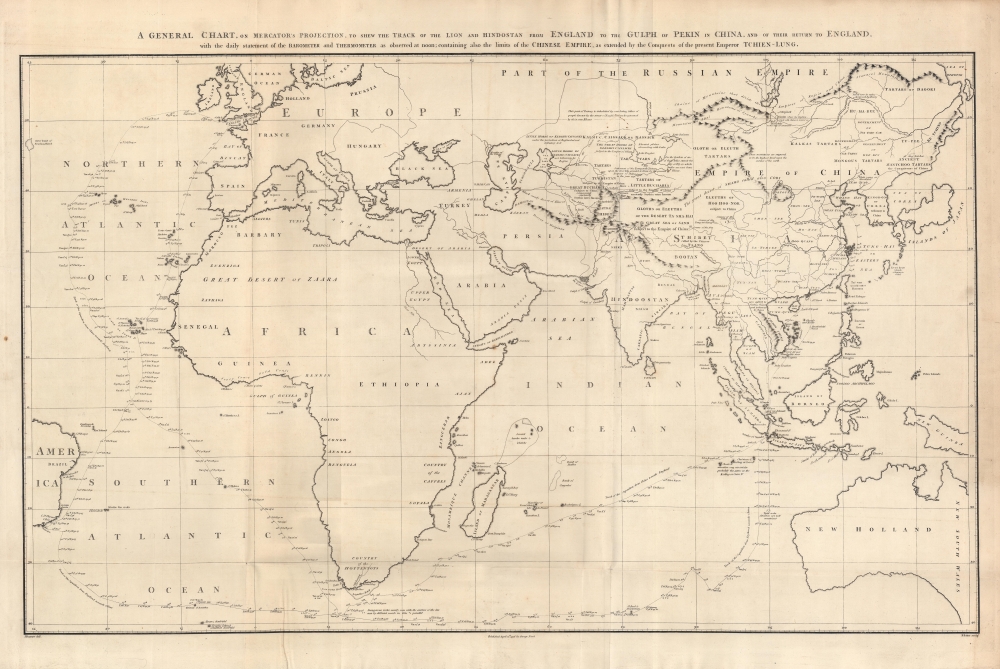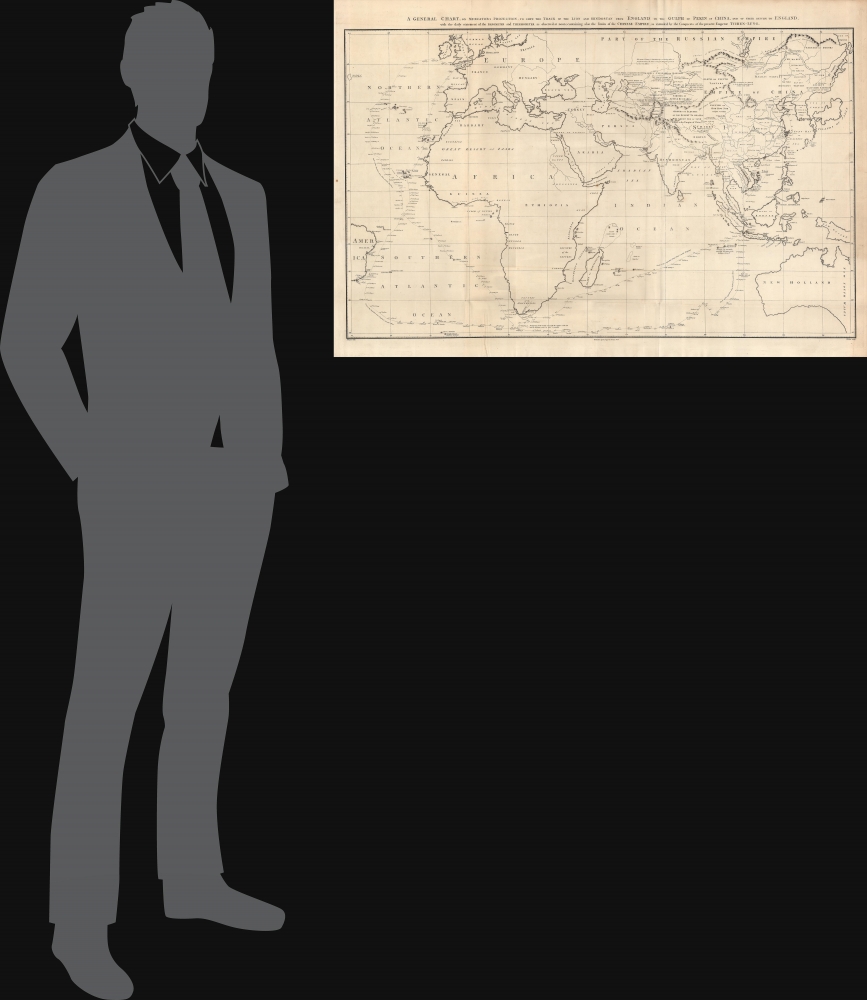This item has been sold, but you can get on the Waitlist to be notified if another example becomes available, or purchase a digital scan.
1796 Barrow Nautical Map of the Macartney Embassy to China
Macartney-barrow-1796-2
Title
1796 (undated) 23.5 x 37.5 in (59.69 x 95.25 cm) 1 : 22500000
Description
A Closer Look
The chart records the track of the squadron carrying the embassy from London to Beijing, from October 1792 to September 1794. It includes readings of atmospheric pressure and temperature recorded daily at noon during the voyage. The map supplies updated information of the political and cultural divisions in China and in the neighboring regions of Asia - many areas of which would still not be mapped in detail well into the 19th century. In some cases, the new Chinese terminology used for an area is shown to replace names drawn from Ptolemy, eg. 'Tartars of Little Bucharia: subject to the Empire of China, anciently Scythia extra imaum.'Sea of Korea vs. Sea of Japan
The sea between Japan and Korea, whose name, either the 'Sea of Korea,' 'East Sea,' or the 'Sea of Japan,' is here identified in favor of Korea (Sea of Corea). Historically, Korea has used the term 'East Sea' since 59 B.C., and many books published before the Japanese annexed Korea made reference to the 'East Sea' or 'Sea of Korea.' Over the centuries, neighboring and western countries have identified Korea's East Sea using various different terms. The St. Petersburg Academy of Sciences referred to the East Sea as 'Koreiskoe Mope' or 'Sea of Korea' in their 1745 map of Asia. Other seventeenth and 18th century Russian maps alternate between 'Sea of Korea' and 'Eastern Ocean.' The 18th century Russian and French explorers Adam Johan von Krusenstern and La Perouse called it the 'Sea of Japan,' a term that became popular worldwide. Nonetheless, the last official map published by the Russians name the East Sea the 'Sea of Korea.' The name is currently still a matter of historical and political dispute between the countries.The Macartney Mission
The Macartney Mission, or the Macartney Embassy, was a diplomatic mission by Great Britain to the Qianlong Emperor of the Qing Dynasty meant to expand British trading rights in China and establish a permanent embassy in Beijing. Thirty-five years earlier, British traders of the East India Company (EIC) were confined to trading with an officially-sanctioned set of Chinese traders in Guangzhou (Canton). Although the Canton System was profitable, the EIC found it too cumbersome and restrictive, while also feeling that a direct line to Beijing was necessary to resolve disputes (rather than working through several layers of intermediaries and bureaucrats). A mission led by Charles Cathcart had been sent to Beijing in 1787, but Cathcart died before reaching China and the embassy was abandoned.George Macartney's mission left Britain in September 1792 with a retinue of translators (including Chinese Catholic priests trained in Italy), painters, secretaries, scholars, and scientists. The well-equipped and impressive embassy traveled via Madeira, Tenerife, Rio de Janeiro, the Cape of Good Hope, Indonesia, and Macau, before moving up the Chinese coast and reaching Beijing on August 21, 1793. Macartney's second in command was George Leonard Staunton who served as the expedition's secretary and chronicler. Staunton's 11-year-old son, George Thomas Staunton, nominally the ambassador's page, learned Chinese during the voyage, became very adept at the language, and served as a translator for the mission alongside the Catholic priests Paolo Zhou (周保羅) and Jacobus Li Zibiao (李自標). The younger Staunton later became chief of the East India Company's factory at Guangzhou, translated works between Chinese and English, and helped found the Royal Asiatic Society (Barrow, who had been the younger Staunton's mathematics teacher, also picked up enough Chinese to help translate and became something of a Sinologist in the years after the embassy's return).
The embassy was poorly managed from the beginning and, despite considerable pomp from the English perspective, appeared poor and rag-tag to the Qianlong Emperor. Partly through lack of preparation, partly through arrogance, and partly due to the emperor's distaste for the British, the embassy failed in all its primary objectives. This disappointing result was compounded by a now-famous letter from Qianlong to King George III that chided the British monarch for his audacity in making demands of the Qing and his ignorance of the Chinese system, ending with a reminder not to treat Chinese laws and regulations lightly, punctuated with the memorable phrase 'Tremblingly obey and show no negligence!'
Macartney's Mission highlighted cultural misunderstandings between China and the West, and has often been taken as a turning point in Chinese history. Qianlong's dismissal of foreign objects as mere toys and his insistence of the centrality of China in the world's hierarchy of kingdoms have been seen as sign of Chinese intransigence and a harbinger of China's awful course in the 19th century. At the time the embassy visited, Qianlong had been in power for nearly sixty years and had increasingly turned over management of the empire to a small group of self-serving officials, particularly Heshen, remembered as the most corrupt official in Chinese history. In the countryside, overpopulation and famine provoked millenarian religious movements and uprisings. On the southern coast, the British East India Company began importing opium in larger and larger quantities, eventually causing a severe social and economic crisis in southern China. In retrospect, both Chinese and foreign historians of every ideological bent have seen the Macartney Mission as a missed opportunity for the Qing to recognize the tremendous changes taking place in Europe and address underlying problems that would eventually sink the empire.
Publication History and Census
The map was drawn by Barrow, engraved by Benjamin Baker, and printed in 1796 to accompany Staunton's 1797 An authentic account of an embassy from the king of Great Britain to the emperor of China, published by G. Nicol in London. It is only catalogued at the University of Wisconsin-Milwaukee, the Caird Library of the National Maritime Museum, the National Library of Scotland, and the National Library of Australia, while the entire Account is listed among the holdings of 13 institutions in North America and Europe in the OCLC.CartographerS
John Barrow (June 19, 1764 – November 23, 1848) was an English statesman, cartographer, and writer active in the late 18th and early 19th centuries. Barrow was born in the village of Dragley Beck, in Ulverston, Cumbria. His first recorded work was as a superintending clerk at a Liverpool iron foundry, but by his early 20s, transitioned to teaching mathematics at a private school in Greenwich. One of his pupils, the young son of Sir George Leonard Staunton, favored him and he was introduced to Lord George Macarteny. Barrow accompanied Macartney as a comptroller of household, on his 1792-1794, embassy to China. Having acquitted himself well, Barrow was hired by Macartney as private secretary on a political mission to the newly acquired Cape Colony, South Africa. Barrow was given the difficult task of reconciling Boer settlers with the indigenous African population. In the course of this voyage he traveled throughout the Cape Colony, coming to know that country well. There he married botanical artist Anna Maria Truter, and, in 1800, acquired a home with the intention of settling in Cape Town. Following the 1802 Peace of Amiens, the British surrendered the colony and Barrow returned to England where he was appointed Second Secretary to the Admiralty, a post he held with honor for the subsequent 40 years. In his position at the Admiralty Barrow promoted various voyages of discovery, including those of John Ross, William Edward Parry, James Clark Ross, and John Franklin. The Barrow Strait in the Canadian Arctic as well as Point Barrow and the city of Barrow in Alaska are named after him. He is reputed to have been the initial proposer of St Helena as the new place of exile for Napoleon Bonaparte following the Battle of Waterloo in 1815. He was a member of the Royal Society and the Raleigh Club, a forerunner of the Royal Geographical Society. In 1835 Sir Robert Peel conferred upon him a baronetcy. More by this mapmaker...
Benjamin Baker (1766 - June 29, 1841) was British engraver active in the late 18th and early 19th centuries. Baker was born in London, the son of instrument maker Edward Baker (1730 - 1797). As a young map he was apprenticed to Thomas Beresford, a watchmaker. This likely did not work out, as he was turned over to the engraver, mapmaker, and globemaker William Palmer (1739 - 1812). Baker rose to prominence as an engraver for the British Admiralty and British Ordnance Survey. In time he became the principal engraver for the Ordnance Survey, not only engraving himself, but overseeing the entire team of Ordnance engravers. His son, Benjamin Richard Baker (1792 - 1876) was also a mapmaker, engraver, draughtsman, lithographer, and printer. Learn More...
George Nicol (1740 - June 25, 1828) was a Scottish bookseller and publisher active in in 18th-century London. Nicol was born in Scotland, but relocated to London in 1769 to work with his uncle, the Strand bookseller David Wilson (17?? - 1777). The two eventually became full business partners, enjoying immense success. When Wilson died in 1777, Nichol took over the business in full. In 1781, Nicol was appointed official bookseller to King George III, a position he maintained until 1820. In 1787 he relocated to Pall Mall, acquiring 51 and 58 Pall Mall, one as a shop and the other as living quarters. Around 1800, his son George Nicol joined the firm, and it was renamed George and William Nicol. When the elder Nichol died in 1828, the firm continued as William Nicol until 1855. Learn More...




